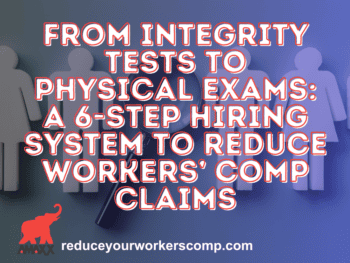
Watch Out for the Ice: A Case Study
A recent case from Minnesota highlights the dangers winter weather presents to workers’ compensation programs. In Thompson v. Minnesota Trial Courts – District[1], the employee fell on a patch of ice while walking to work. In a nutshell, the facts of the case are as follows:
- Due to security concerns, the employer instructed all non-essential employees to leave and bring any needed work equipment home.
Click Link to Access Free PDF Download
“The 5Cs to Taking a Bulletproof Injured Worker Recorded Statement”
- Several days later, impacted employees were instructed to return to the workplace. The employee packed his work equipment and traveled back to his office. The wintery weather included slippery roads and sidewalks.
- Due to security issues, the employee could not enter the workplace through the normal entry. This required the employee to use a different parking lot and a slippery public sidewalk from the wintery conditions and weather.
- The employee was walking carefully but slipped on a patch of ice in a public plaza area and sustained injuries. The employee was roughly 70 feet from the work premises at the time of the incident.
- Primary liability was denied. The compensation agreed and denied the claim. The employee appealed.
The appeals court affirmed the compensation judge’s decision.
Case Analysis and Commentary
This is a close case that underscores the need for all interested stakeholders to coordinate and work together to find success. It also requires analysis from several angles that likely include the use of all interested stakeholders. Drilling and getting all information includes a complete investigation and documentation of the work injury.
- Special Hazard Exception: The employee argued the work injury was compensable given the hazards created by the environment. The Court rejected this argument as the icy sidewalk was not connected to anything related to the work environment. This included the fact that the employee had several different entry points to the work premises. The unique factor of carrying work equipment was also deemed irrelevant.
- Special Errand Exception: Work injuries sustained while carrying out “special errands” for the employer can also be found compensable. In this instance, the Court found this exception not applicable because bringing a laptop and other work items back to the premises rose to the level of an errand. It was also noted that returning work equipment to the premises was “merely incidental” to the employment setting.
- Street Risk Exception: The Court also rejected arguments that the risk incurred on the “street” did not compensate for the injuries from the slip and fall. In reviewing this argument, the Court noted, “the evidence in this case does not compel a finding that the employee was brought 70 feet from the door of the building…by the employment.”
Issues of primary liability are won and lost based on the facts of the case. Members of the claim management team can find success in cases like this by considering the following:
- Encourage promote and timely reporting of all work injuries;
- Preserving evidence and conducting a complete investigation;
- Filling in the blanks and being precise, such as distances from entryways, alternative routes to enter the workplace, and demands placed on employees and
- Analyzing defenses, knowing the law, and correctly applying it.
While the exact details of this case are unknown, what is going on behind the scenes is apparent. The claiming team worked with defense counsel and prevailed on a fact-dependent denial.
Conclusions
Slip and fall work injuries that occur when an employee is leaving or injury will continue to dominate the workers’ compensation system when the snow is flying, and it is cold outside. Working as a team to defend these cases can reduce workers’ compensation program costs when closely investigated and there is coordination between the defense interests. It also requires understanding the law, which is accomplished through teamwork.
[1] Case No. WC23-6519 (01/26/2024 MN WCCA).

Contact: mstack@reduceyourworkerscomp.com.
Workers’ Comp Roundup Blog: http://blog.reduceyourworkerscomp.com/
©2024 Amaxx LLC. All rights reserved under International Copyright Law.
Do not use this information without independent verification. All state laws vary. You should consult with your insurance broker, attorney, or qualified professional.

















